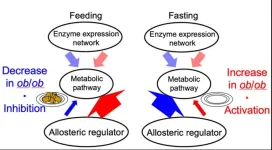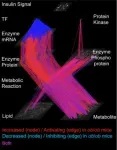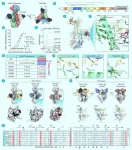Your liver plays a vital role in your metabolism, the biological process which converts food into energy. We know that being overweight can negatively affect metabolic activity, but not exactly how. To better understand this, researchers compared the livers of mice which were a typical weight with mice which were obese. They were surprised to find that biological regulation of metabolic activity, after a period of feasting and fasting, was reversed between them. In typical mice, allosteric regulation (the process which controls metabolism) was inhibited during feeding and activated when fasting. However, in obese mice, allosteric regulation increased during feeding and decreased when fasting. Investigating the reasons behind this reversed biological behavior could help health professionals understand how obesity affects the body and the development of disease.
The World Obesity Federation (WOF) estimates that by 2035, over 4 billion people will be overweight or living with obesity. This may lead to a rise in obesity-related health conditions, such as heart disease, nonalcoholic fatty liver disease and Type 2 diabetes. Identifying the causes and effects of obesity, which is now understood to be a complex disease, is key for physicians looking to provide support and help people stay healthy.
One known way that obesity can affect health is by impacting metabolism, the process by which our bodies take in, store and use energy from our food. Certain organs play key roles in this process, notably the liver. Not only is food processed there to provide energy, but it is one of the places where useful products at the end of the metabolic process are stored until we need them. To better understand the effects of obesity on the liver, researchers compared the livers of typical mice and obese mice after periods of feeding and fasting.
The team carried out trans-omics analysis, an approach where they gathered data on five sets of biological processes (multi-omics). They then combined these layers of data with information from biological databases to create a trans-omic network. This gave them an overview of how the different layers interacted. “We constructed a trans-omic network of metabolic reactions in the livers of mice that could feed freely. We then compared this with data we had previously gathered from mice that had fasted for 16 hours,” explained Professor Shinya Kuroda from the Graduate School of Science at the University of Tokyo. “While enzyme and allosteric regulation which controls metabolism was suppressed in typical mice during feeding, we were surprised to find that the reverse occurred in obese mice and that this activity increased.”
When we eat, our liver builds up stores of energy which is then released as needed, a system known as metabolic homeostasis. However, the researchers saw that in obese mice this equilibrium became dysregulated, i.e., normal function was disrupted, indicating a potential breakdown of the system. This could lead to metabolic disorders such as tiredness, lack of energy and decreased appetite. By contrast, they saw that transcriptional regulation, a process which regulates metabolism and controls cell activity at a genetic level, did not change much between feeding and fasting. This means that, compared to allosteric regulation, it is more stable and less affected by what we eat.
The team noted that what they observed may not only be evidence of disruption within the liver alone, but a change to broader metabolic cycles throughout the body. “Obesity is a metabolic disease, so to understand it, it is important to construct a trans-omic network with metabolome (the complete set of small-molecule chemicals) at its center,” said Kuroda. “We are interested not only in the liver, but also how the products of metabolic reactions circulate between liver and muscle through the blood in obese mice, which is what we will be working on now.”
#####
Paper Title:
Yunfan Bai, Keigo Morita, Toshiya Kokaji, Atsushi Hatano, Satoshi Ohno, Riku Egami, Yifei Pan, Dongzi Li, Katsuyuki Yugi, Saori Uematsu, Hiroshi Inoue, Yuka Inaba, Yutaka Suzuku, Misaki Matsumoto, Masatomo Takahashi, Yoshihiro Izumi, Takeshi Bamba, Akiyoshi Hirayama, Tomoyoshi Soga, and Shinya Kuroda. Trans-omic analysis reveals opposite metabolic dysregulation between feeding and fasting in liver associated with obesity. iScience. DOI: 10.1016/j.isci.2024.109121
Funding:
This research was supported by the Japan Society for the Promotion of Science (JSPS) KAKENHI Grant Numbers JP17H06300, JP17H06299, JP18H03979, JP21H04759, CREST, The Japan Science and Technology Agency (JST) (JPMJCR2123), and by the Uehara Memorial Foundation.
Y.B. receives funding from China Scholarship Council Grant Number 202008050067.
K.M. receives funding from a Grant-in-Aid for Early-Career Scientists JP21K15342.
T.K. receives funding from JSPS KAKENHI JP21K16349.
S.O. receives funding from a Grant-in-Aid for Early-Career Scientists JP21K14467.
K.Y. receives funding from JSPS KAKENHI Grant Number JP18H05431, and CREST, JST JPMJCR22N5
S.U. receives funding from JSPS KAKENHI Grant Number JP19J22134.
Y. Inaba receives funding from the Japan Agency for Medical Research and Development (AMED) through the Practical Research Project for Lifestyle related Diseases including Cardiovascular Diseases and Diabetes Mellitus Grant Number JP21ek0210156.
Y.S. receives funding from JSPS KAKENHI Grant Number JP17H06306.
M.T. receives funding from JSPS KAKENHI Grant Number JP20K15101.
Y.Izumi receives funding from JSPS KAKENHI Grant Number JP22H01883.
T.B. receives funding from JSPS KAKENHI Grant Number JP17H06304 and JP17H06299.
T.S. receives funding from AMED under Grant Number JP21zf0127001.
Useful Links
Graduate School of Science: https://www.s.u-tokyo.ac.jp/en/
Department of Biological Sciences: https://www.bs.s.u-tokyo.ac.jp/english/about_us/faculties/biology.html
Research Contact:
Professor Shinya Kuroda
Department of Biological Sciences
Graduate School of Science, The University of Tokyo
Hongo 7-3-1, Bunkyo-ku, Tokyo 113-0033
Email: skuroda@bs.s.u-tokyo.ac.jp
Tel.: +81 3 5841 4697
Press contact:
Mrs. Nicola Burghall
Public Relations Group, The University of Tokyo,
7-3-1 Hongo, Bunkyo-ku, Tokyo 113-8654, Japan
press-releases.adm@gs.mail.u-tokyo.ac.jp
About the University of Tokyo
The University of Tokyo is Japan's leading university and one of the world's top research universities. The vast research output of some 6,000 researchers is published in the world's top journals across the arts and sciences. Our vibrant student body of around 15,000 undergraduate and 15,000 graduate students includes over 4,000 international students. Find out more at www.u-tokyo.ac.jp/en/ or follow us on Twitter at @UTokyo_News_en.
END








